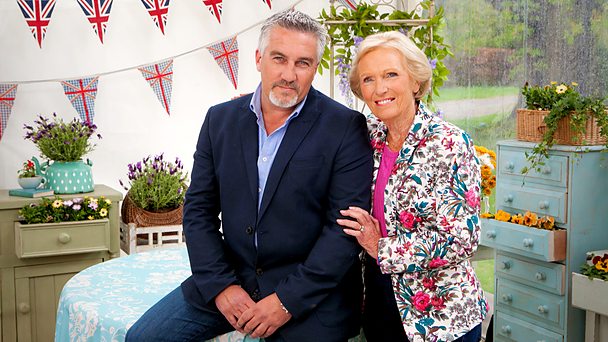By Will Jamieson

Judges Paul Hollywood (left) and Mary Berry (right) have been a huge factor in the nation embracing the programme | Photo: BBC
It is five years since the Great British Bake Off first hit our screens, and in that time, the show has had unpredictable success. Viewing figures have continued to rise, with a massive 13 million tuning in to the 2014 final. It has become commonplace that once every week the nation is captivated as amateur contestants, armed with butter, eggs and flour, stand with their wooden spoons and their mixing bowls and wait for the now famous Klaxon call: “Ready, set, bake!”
With those words, audiences become immersed in Bake Off’s cheerful world of quintessentially British bunting-draped marquees and the sheer drama of ‘soggy bottoms’ and ‘showstoppers.’ It’s an old-fashioned, weekly village fete right in your living room, except instead of your standard lemon drizzle cake, there is an exact gingerbread replica of the Coliseum, all served on doilies, bone china and cake-stands, and with a steely, blue-eyed glare from co-judge Paul Hollywood. But what is it about the show that has meant we have embraced it with open oven mitts? And has it turned us into a nation of bakers?
As the “bake-off effect” takes hold, googling the name “Mary” results in the mother of Christ coming second to the lady who sports floral jackets and makes the best Victoria sponges in all the land, Great British Bake Off judge Mary Berry. This very fact is a mark of the series’ unbelievable impact, which continues to expand like a well proved dough. Once upon a time, viewers pondered storylines with burning questions such as “Who shot Mr Burns?”, “Who is Gossip Girl?”, and just about everything in Lost, now we wonder, “Who sabotaged Iain’s Baked Alaska?”
That controversy, now notoriously known as “Bin-gate”, saw madness ensue as newspapers dedicated a Watergate-level publicity and storms erupted in the Twittersphere, with a total of 118, 144 tweets sent by social media users – a ridiculous 3,948 tweets per minute, over the scandal involving one contestant sabotaging another’s Baked Alaska.
Since it’s birth in 2010, the austerity-friendly show has amassed millions of viewers each year and has been credited for the national revival of home baking. According to retail analyst Conlumino, a quarter of adults now bake once a week. “The impact has been huge,” said amateur baker Claire Keaton. “A lot of people simply buy cakes without any thought about what goes into them. But now I think the Bake-Off has inspired people to learn to bake for themselves. It certainly has for me anyway.”
It is not just women that are donning their aprons and taking to the kitchen. Two out of three of the previous Bake Off winners have been men. Mike Warren, who recently joined a baking club, said: “There used to be a lot of taboos around male bakers, but I think Bake Off has changed that.”
This year’s show saw Martha Collison become the youngest ever contestant to feature in the programme at just 17, and it would seem that she is just one of a increasing number of young people trying their hand at baking. “I have seen a definite impact of the Bake-Off on the younger generation,” home economist and lecturer Sophie Thatcher said. “For instance, my children never used to want to bake, but now they do.”
Today, the British baking industry is worth £3.4 billion, and it would seem the show has sparked an unprecedented boom in sales of baking supplies. No kitchen is complete without a piping bag, edible rose petals or mini blowtorches. A spokesperson for Kitchenware shop Lakeland said: “It’s shows like the Bake Off, coupled with the trend for ‘home-made is best’ that has led to soaring sales.”
The “bake-off effect” is also having an impact on consumer’s shopping lists and ingredients are flying off the shelves. At Morrisons, shoppers now buy 23,000kg of flour, 360 litres of vanilla extract and 15,000 bottles of food colouring each week. Waitrose reported a 25% lift in sales of the glacé cherries after contestants competed to make their own version of Mary Berry’s cherry cake in a recent episode. “Each week, customers are inspired to bake what they have seen,” explains Charlie Osborne, a store manager at Morrisons.
And it’s not the only area that is booming. Simple Business Insurance received 2,000 quote requests from cake entrepreneurs in 2012: an increase of 325 per cent since Bake Off began. Emma Pitt is one such entrepreneur making the jump from amateur to professional, after opening a bakery in 2012. “The response has been more than I ever could have wished for,” she said. “Much of my inspiration came from Bake-Off and making the decision has changed my life.”
One only has to take a glance at Amazon’s best sellers to see that the Bake Off really has infiltrated the nation as titles such as Mary Berry’s Baking Bible and Paul Hollywood’s Pies and Puds dominate the charts. Bake-off inspired amateurs are also attending baking clubs and classes. Since the start of the show, there are now 200 regional organisations, with 10,000 bakers sharing 7,000 cakes. “Baking clubs are the new book groups and I hope they are here to stay,” said Kate Tyler, member of one such club in Marlborough. Others are turning to classes to bolster their skills, with 5.2 per cent of Britons have taken a lesson this year, according to Conlumino. Baking teacher Hannah Brewin said: “Our students are embracing baking as a serious hobby.”
Trends come and go but with the Great British Bake Off continuing to rise, and people of all ages and both genders trying their hand at being star bakers, the format is in no danger of being under-baked just yet.


